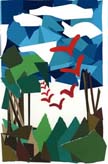from Erica Jacobsen, JCE High School Editor
“When it rains, it pours.” The classic Morton Salt slogan pops into my head every once in awhile when I use the salt shaker. I appreciate the cleverness of taking the original meaning of the idiom, and exchanging it for the meaning that the salt doesn’t clump, even when its surroundings are humid. The idea of more than one meaning for a phrase was even part of the sermon preached at my wedding. It focused on “picture-perfect love” and “picture perfect love”. What a difference a hyphen can make! My Especially column in the February 2008 issue of the Journal of Chemical Education focused on the Chemists Celebrate Earth Day (CCED) theme “Streaming Chemistry”, but highlighted two meanings of the phrase. This year’s CCED theme, “Air—The Sky’s the Limit” inspires me to do the same.
The Sky’s the Limit, I
At a recent American Chemical Society (ACS) ChemClub Advisory Board meeting, we took time to engage in “The Sky’s the Limit” thinking. We used the power of brainstorming and big thinking to generate ideas about where the ChemClub program could go. “What if we…” “We could…” Sure, not all of the ideas will be used, but developing such a list brings the true gems to the forefront.
Kirchhoff and Zare’s Report “Charting a Course for Chemistry Education” encourages similar thinking to benefit science education. They describe the challenge of the American Chemical Society’s newly-created Presidential Task Force on Education. The Task Force requests suggestions and plans as to how the ACS “can have a special, transformative effect on education in the United States”. It could be on any level from K–12 and beyond, informal or formal education, at the federal, state, or local level. They want to hear your “sky’s the limit” thinking before the March ACS National meeting. At the fall ACS meeting, the Task Force will present its recommendations of “a few outstanding proposals that the ACS is uniquely qualified to make work”. I’ve already marked up the margins of this article with my ideas to send in. Add your voice—by email or mail or join the discussion on the blog.
The Sky’s the Limit, II
Articles in this Earth Day issue take the phrase literally, in their focus on myriad topics related to air and the atmosphere. Lynn Diener, recently of the Journal of Chemical Education and National Science Digital Library staff, is now a member of the Mount Mary College faculty. Even though she’s only in her first semester there, the sky was really the limit for her. She penned this month’s News from Online column and then considered graphics choices to accompany the text. In the end, she decided to launch a collaboration with a member of the Fine Arts Department, and challenge both art and science students to create atmosphere-related artwork for the pages (and cover) of JCE. The results are amazing; my favorite composition “Jungle Fever” is on the pages of this month’s JCE resource paper. Laura’s favorite is shown here.
“Open Air”, by Sara Terrell. Laura says “It reminds me of how much things can adapt even when we think they cannot”.
My “sky’s the limit” thinking about the JCE Classroom Activity series started about ten years ago when I began work on the feature. Could we make it to #100? At times it seemed nearly impossible. But this month it’s here! Thank you to Johnson and Van Milligan
for sharing their Activity. Students use the ideal gas law and helium-filled Mylar balloons together in an unexpected way.
Laura’s Take on the Issue
from Laura Slocum, JCE High School Associate Editor
I am a little embarrassed to admit this, but I have NEVER celebrated Earth Day in my classroom. However, the articles in this month’s issue excited me. 2009 is the year! I will reconfigure my syllabus and save gases and gas laws until April and will celebrate Earth Day using the 100th Classroom Activity. The Activity really captivated me; I tried it immediately. I know my students will love it.
I also shared the article by Schilling, Leber, and Yoder with our Environmental Science instructor, and we are going to work together on incorporating their project into our two classes. All students take chemistry in their sophomore year, so this spring I will incorporate the necessary laboratory techniques into a lab that I now use in my chemistry class. Since Environmental Science is an elective course after chemistry, he will use the SO2 labs described in the article in his course the following year. In this way, the students will have used the laboratory techniques before and he and I will be making connections, reinforcing ideas and topics, and supporting each other.




* You can follow any responses to this entry through the RSS 2.0 feed.